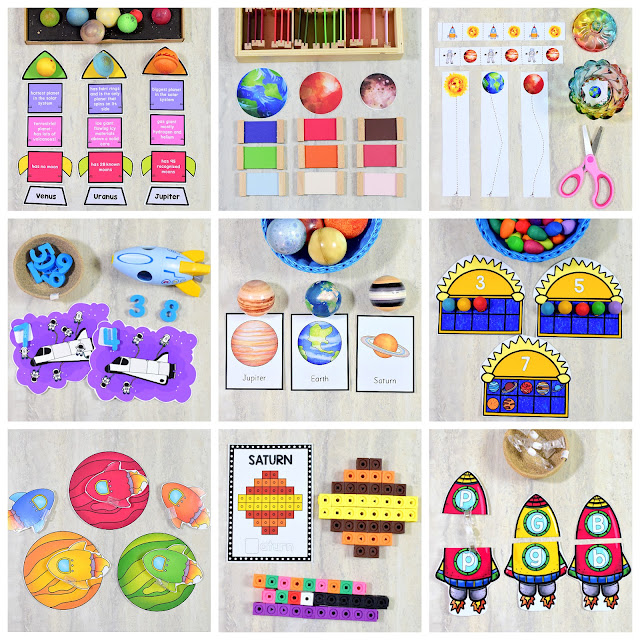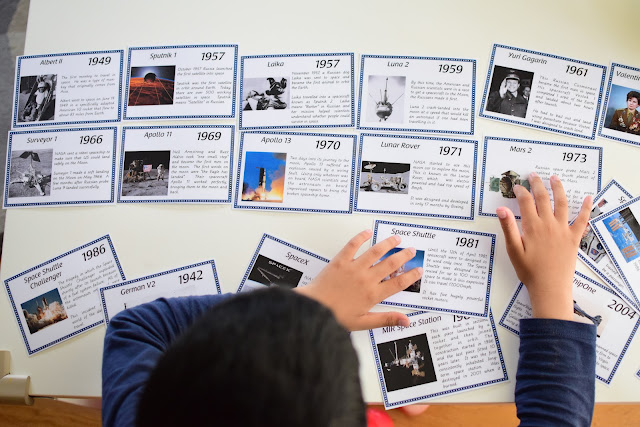Fun Thermometer Reading in Space
Thursday, November 1, 2018

Montessori Inspired Space Themed Learning Activities
Saturday, February 10, 2018

Hands-on Learning of Constellations for Preschoolers
Thursday, February 8, 2018

Phases of the Moon Learning Pack
Monday, February 5, 2018
Now, this post contains some of the activities we did to learn about the moon phases. These are hands-on activities, and we used most of our printed materials from my shop. Continue reading the post to learn more about it.

Sparkly Planets for your Solar System
Wednesday, July 12, 2017
We’ve done this before (in 2013) and we made another one again! Creating our planets for our solar system using aluminium foil. Have done this before? I mentioned the source of this activity in my previous post, read it here.
Introducing the Solar System to Preschoolers
Thursday, April 13, 2017
How to Introduce Space and Planets to Toddlers
Tuesday, April 12, 2016
The Perfect Moon Sand (Cloud Dough) Recipe
Thursday, March 31, 2016
Dear friends, I’m very busy and I don’t have an easy access to products that are sometimes required to create a dough or a slime. So when I discovered this 2-ingredient cloud dough from Happy Hooligans, I was ecstatic! To make a moon sand or cloud dough, you just need a lot of plain flour and baby oil. That’s just it! Check the site for the measurements, the outcome was fantastic!
Painting the Moon
Sunday, March 27, 2016
Vito is 28 months old.
We have an amazing full moon during Holy Week so I encouraged the boys to the paint the moon. I can’t believe that it turned out so beautiful and realistic! The craters are naturally formed and the color combination of paints were fantastic. The best part about this is that it’s so simple to make!
Science Experiments: Twinkle Twinkle Stars and {Learn & Play Link Up}
Wednesday, November 4, 2015

Objective: To simulate the twinkling of stars in sky.
Materials needed:

Procedure:
1. Crumple your square foil and place it on a table or on a floor.
2. Fill your clear bowl with tap water and place it on top of the crumpled foil.

3. Darken the room by turning off the lights. Hold the torch or flashlight above the bowl. Distance from the bowl is about 12 inches.
4. Observe the foil through the undisturbed water.

5. Now using your pencil, tap the surface of the water gently. Observe the foil through the moving water.


What happened?
The light rays reflecting from the foil when there was a movement in water appears to blur or twinkle.
Why?
The movement of the water causes the depth of the water to vary. The light rays twinkle because they bend or refract in different direction when it passed through the different depths of water.
This is similar to the light rays of the stars. They appear to be twinkling when you are observing from earth because they refract differently as the light rays move through the different thickness of air in the atmosphere. Scientifically, this twinkling phenomenon is called ‘scintillation’.
Follow us on Facebook, Pinterest, Google Plus, Instagram or Twitter for updates!
And you might as well PIN this post for future reference.

Source: Janice VanCleave Astronomy

- Montessori Education
- Homeschool
- Sensory Play
- Tot and Preschool Trays
- Fine and Gross Motor Activities
- Kids in the Kitchen
- Healthy Recipes for Kids
- Arts and Crafts
- Natural Living
- Free Educational Printables
- Family-Oriented Activities
- Healthy Living
GUIDELINES FOR LINKING
- Please link up 1-3 posts
- Follow each of the hosts on social media
- When you link up, please add our button and place it at the bottom of your shared posts or link back with text link.
- By entering a link, you’re giving us permission to feature an image on our blogs. Proper credit & links will ALWAYS be given.
- Please visit a couple of shared posts and leave a comment for them
- Remember that you must link back in order to be featured
<div align="center"><a href="http://christianmontessorinetwork.com/category/learn-and-play" title="Christian Montessori Network"><img src="http://www.christianmontessorinetwork.com/wp-content/uploads/2015/04/learn-and-play-link-up-150-150.png" alt="Christian Montessori Network" style="border:none;" /></a></div>
Please Follow
Follow Pinay Homeschooler's board Pinay Homeschooler on Pinterest.
Guide to Space and Heavenly Bodies Study for Kids (with FREE Resources)
Friday, July 10, 2015

Space and Solar System
Solar System and Planets Part I
Solar System and Planets Part II
Planets and Solar System for Preschoolers
Moon Phases
The Moon
Phases of the Moon
A look at the Northern and Southern Sky
We looked into the star constellation maps seen in the northern and southern hemisphere. This is to make Mavi aware that there are stars that can be seen in the northern part of the world but not visible on the other side.
Stars and Constellations
For the details of our constellation study, click here or click the image below. The material we used here is the Fantacolor pegboard.

Space Exploration History
I made chronological cards of the space exploration history. The pictures and the fact cards were all taken and referenced from Wikipedia and Wiki Commons. Though Mavi can read this straight from the site, I wanted to have something tangible and something that we can work on, like arranging the timeline and matching it with objects.

The cards I created contains the year and a title of the major event that occurred in that year. The description is very much readable by kids though there were a few words that Mavi couldn’t pronounce well or he needed to ask me for the meaning. Such a good material to improve reading skills, spelling and vocabulary!

After which, I showed him how we can arrange the cards according to their timeline. This gives him a visual presentation of the order of events.

Aside from arranging the cards chronologically, you can also use them to match objects. Here we used Safari Toobs Space, Safari Toob Insects (fly) and Safari Toob Farm (dog).

So if you wanted to have a copy of the cards for Space History Timeline, click here for the link.
Parts of a Space Shuttle
The parts of a space shuttle is something that Mavi really looked forward to. Oh boy he was so happy that I made him another “flying object”. The first one was the Airplane Nomenclature Cards, and here’s the newest Space Shuttle Nomenclature Cards. This is based on the NASA’s space shuttle design. Using the cards, a child will learn the different parts of a space shuttle. I wrote the parts’ functions in a notebook because I was out of ink.


To get a copy of the Space Shuttle Nomenclature Cards, click here.
Sensory Tub
Now, this is something I prepared for both of the boys to play with. Xavi had his own Letter S: Star Unit study last week so it was timely that I prepared this Space Sensory Tub for the boys. Figures are from Safari Toob Space, homemade PlayDoh planets and homemade Earth felt.
FREE Space Exploration History Learning Cards
Thursday, July 9, 2015
FREE Space Shuttle Nomenclature Cards
Sunday, July 5, 2015

Download your FREE copy of Space Shuttle 3-part cards! Hope you like it. Enjoy!
Study of Star Constellation Maps for Kids
Saturday, July 4, 2015

Our materials for the study include homemade star constellation maps and Fantacolor pegboard.
The cards are so easy to prepare: black cardstock, silver or gold star stickers and a silver/gold marker.

The Fantacolor pegboard was used by Mavi to recreate each constellation…

…and identify their brightest stars.

Ursa Major, Ursa Minor and Polestar (Big Dipper, Small Dipper and Polestar)

| Common Name | The Scorpion |
| This constellation contains some of the most spectacular stars, nebulae and star clusters. Closest to Milky Way | |
| Visible from | Worldwide |
| Location | Southern Hemisphere |
| Best time to see | After sunset of April to September |
| Brightest Star | Antares |
| Common Name | The Lion |
| Lies afar from the band of Milky Way. | |
| Visible from | Worldwide |
| Location | Northern Hemisphere |
| Best time to see | After sunset of February to June |
| Brightest Star | Regulus |
| Common Name | The Archer |
| This has a vivid constellation and lies in the southern half of the sky. It is rich in star clusters and nebulae. This constellation shines brightly because the middle of the Milky Way lies in its borders. | |
| Visible from | Worldwide |
| Location | Southern Hemisphere |
| Best time to see | After sunset of July to October |
| Brightest Star | Kaus Australis |

| Common Name | The Hunter |
| This is the brightest and most popular constellations in the entire sky. It is exceptional since it can be seen from both the North and South Poles. | |
| Visible from | Worldwide |
| Location | Mid Latitude |
| Best time to see | After sunset of December to March |
| Brightest Star | Rigel |
Taurus
| Common Name | The Bull |
| The constellation looks like the front of a mighty bull charging towards the Orion. | |
| Visible from | Worldwide |
| Location | Northern Hemisphere |
| Best time to see | After sunset of November to February |
| Brightest Star | Aldebaran |
Cygnus
| Common Name | The Swan |
| This constellation contains many fascinating stars and nebulae. The pattern creates a distinct cross (known also as the Northern Cross) | |
| Visible from | Worldwide |
| Location | Northern Hemisphere |
| Best time to see | After sunset of July to November |
| Brightest Star | Deneb |
We are continuously learning about space. Currently, we’re looking at the chronological timeline of space exploration history and how space shuttles work. This has been a very fruitful topic for Mavi, and I am learning a lot as well! More posts about Space Study coming up in the next few days. Stay tuned!
Don’t forget to follow us on Facebook, Instagram, GooglePlus, Twitter and Pinterest for updates and freebies!








![DSC_0049_thumb[4] DSC_0049_thumb[4]](https://blogger.googleusercontent.com/img/b/R29vZ2xl/AVvXsEhmCgtxaANRLdKD2a9Nzhj_YosdZFkNOxMOPwGryOX-RBspICr6IxXjBUKMZwFt5DNSZ1HRw0nWtZPdrMNocdjlo07OO-0rbLi-KGa6xD7G5oJ9f2guZ76uRqFRKguDlriuuEyGRn6Iwz9t/?imgmax=800)
![DSC_0428ii_thumb[5] DSC_0428ii_thumb[5]](https://blogger.googleusercontent.com/img/b/R29vZ2xl/AVvXsEhWe9HaFYg8pQTOJ1q8ksXDQUp-J9nRBo82PP8tMNEkXnIRV145SjcB_ZYCeKO_nyAAOTmYVc3gTapixD8Yu_WTGwnuFBL-VmDQoBatWlrGtJig05ha4Z5ryeulNDO_OLqmfNWFn-H6ymbb/?imgmax=800)
![DSC_0328_thumb[3] (1) DSC_0328_thumb[3] (1)](https://blogger.googleusercontent.com/img/b/R29vZ2xl/AVvXsEgUo5piUo3Xd97sYGZjHRFO8lmaW52Fs9gMspkAlgtByHxxQ5vaY8YfrlzIXJ3b8ypxOL3qpBLABu_GN6mI5G3a-mWyBqlj3Z0p_ow91C9xhPHBajLsbjYjoNE3DZKPh4qwZ0VZo74IyqNz/?imgmax=800)
![DSC_0032[7] DSC_0032[7]](https://blogger.googleusercontent.com/img/b/R29vZ2xl/AVvXsEix4B12K66f99kXY-Aw3VtECIKn71yRCIPEQFtie8MQ8tLAvYl9iskTzCPvDKFBEpqhHPfaG1708WXojP4YxYvbzmY6nv-DSzZl10pN_31ncbUAmbNKrRZ_xAO4Wd7vaArVVyrtLnYd0Qkd/?imgmax=800)










